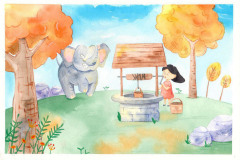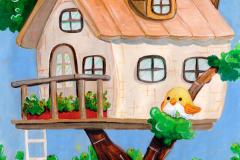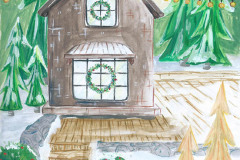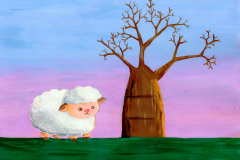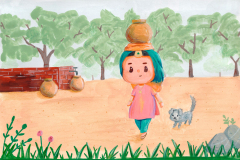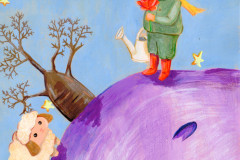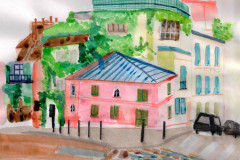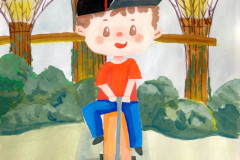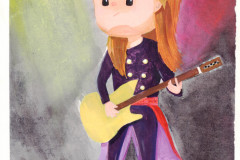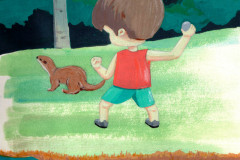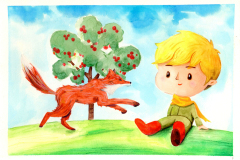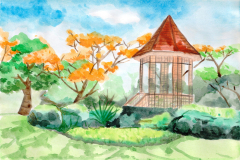Introduction
Environmental art captures the relationship between humans and nature through creative expression. It is more than just creating art with natural materials; it speaks for the planet by raising awareness about ecological issues and our impact on the environment. You can craft art that does not only reflect beauty but also carries a message about the natural world.
This article explores how you can create environmental art that connects deeply with nature and society. You will learn about the history, key concepts, materials, and practical tips to make your artistic voice resonate with environmental themes. By the end, you will have insights to start crafting your own environmental art that speaks for the planet.
The History of Environmental Art
Environmental art didn’t just appear out of nowhere. It grew from earlier artistic forms that had a close relationship with nature, though they weren’t always labeled as environmental. Think about paintings centuries ago that captured forests, mountains, or rivers. These weren’t just decorative; they reflected an interest in the natural world, even if the artists didn’t focus on environmental issues as we understand them today.
Later, as people became more aware of human impact on the planet, art began responding differently. In the 1960s and 70s, there was a noticeable shift. Artists started to move beyond traditional galleries, working directly with land itself. This shift led to what’s called land art, where the environment became the canvas and materials. Instead of depicting nature, the art became part of it.
Alongside land art, site-specific projects emerged. These works were designed for particular places, often addressing local ecological or social contexts. This wasn’t just about aesthetics; it was also about raising awareness, provoking thought, or inspiring action. You could say environmental art evolved from showing nature to engaging with it—and sometimes, confronting human effects on the planet in quite direct ways.
Have you ever wondered how making art outside traditional spaces changes viewers’ experiences? This historical journey shows that environmental art occupies a unique position between nature and society, always adapting but never fully settling into a single form.
Early Influences from Landscape Painting
Before environmental art took its current form, artists were already drawn to nature through landscape painting. Think of painters like Turner or Constable, whose works captured not just the beauty of the natural world, but also its moods and atmospheres. These paintings often reflected changing human relationships with the environment—sometimes romanticizing it, sometimes suggesting a fragile balance.
It’s interesting how these early artworks weren’t always about environmental concerns as we understand them today. Yet, they laid a foundation for thinking about nature as a subject worthy of attention beyond just pretty scenery. They made people look closely, and perhaps that gaze slowly shifted into something more engaged and urgent. You could say these paintings hinted at environmental art, even if unintentionally.
The Shift to Land and Site-Specific Art
In the 1960s and 1970s, there was a palpable change. Artists grew restless with traditional canvases. Instead, they turned outdoors, creating works right in nature. This move, often called land art or earthworks, made the environment itself part of the art. Rather than depicting nature, artists physically interacted with it.
Think of pieces like Robert Smithson’s “Spiral Jetty” or Nancy Holt’s “Sun Tunnels.” These works aren’t just inspired by nature; they coexist with it and invite viewers to experience the site directly. This shift also brought a dose of activism, asking people to consider human impact on the landscape. But I sometimes wonder, does making art in nature risk disturbing it? That tension feels built into environmental art from that time onward.
What this period shows is a move away from seeing nature as a backdrop, to viewing it as an active participant—sometimes fragile, sometimes resilient—in the artistic process. It’s a turn that still influences environmental art today.
Choosing Your Materials
Using Natural Materials
Natural materials do more than give environmental art a certain look or feel—they connect your work directly to the Earth. When you choose earth, wood, stone, or plants, you allow the medium itself to tell part of the story. Dirt can carry the memory of place, wood holds the life cycle of a tree, stone keeps ancient marks, and plants bring growth or decay into your work. These materials aren’t just passive; they react and change over time, adding layers of meaning.
For example, using fallen branches rather than cut ones can help keep a project from feeling imposed on the environment. Stone pieces gathered from a local stream might also reflect the geology of the site you’re working in. It’s tempting to reach for sculptural materials that are easy to shape or transport, but natural materials remind us that the planet itself shapes the art.
Sourcing Sustainable Materials
Finding materials responsibly means balancing your creative vision with the wellbeing of the environment. It’s not always clear where that line sits. Asking questions helps: Are the materials already detached from life, like fallen leaves or driftwood? If you need something alive, do you have permission to harvest it without damaging a larger system?
Sourcing locally prevents unnecessary shipping impacts and helps you understand the story behind your materials. Think small-scale collection, rather than pulling from endangered areas or protected habitats. Sometimes, reclaimed materials—old wood or stone from demolished structures—can serve your work and keep waste out of landfills. It’s a bit of an art in itself to track down these resources, but it’s worth the effort if you want your piece to truly respect the planet.
Sometimes, sustainable sourcing means accepting limits or making compromises. Your art might grow more interesting when it’s shaped by what nature offers, rather than what you demand. That unpredictability, I think, is part of why environmental art can feel so alive.
Finding the Right Location for Your Art
Understanding Site-Specific Art
Site-specific art isn’t just about putting a piece in a spot that looks nice—it’s about creating something that truly belongs to that place. The location shapes the meaning of the artwork, sometimes in ways you might not expect. For environmental art, this connection becomes more critical. The environment isn’t just a backdrop; it’s part of the message itself.
For example, a sculpture placed near a polluted river can make a stronger ecological statement than the same piece displayed in a gallery. The surroundings bring context and tension. Site-specific art often reacts to the history, the ecology, or the community of the place.
But sometimes the location challenges the artist. The natural setting might change with the seasons. Weather might damage your work. These tensions add a layer of complexity, which, if you embrace it, can enrich the piece’s dialogue with the environment.
Tips for Choosing a Location
Picking the right site means considering a few critical points. Start by visiting the potential place several times, at different times of day and in different weather conditions. Notice how light falls, what sounds fill the air, who else uses the space.
- Ask yourself if the location highlights or distracts from your message.
- Think about accessibility—will people engage with your work or walk right past?
- Consider how your materials will hold up against the local climate.
- Check if your art can interact with local plants, animals, or geological features without causing harm.
- Look for spots that carry a story you want to tell or a problem you want to expose.
Sometimes the best locations are unexpected—an abandoned lot, a roadside verge, or the edge of a forest. I once placed a small piece near a quiet wetland, and it surprisingly sparked local interest in protecting the area. That’s the power of thoughtful placement.
You may find that choosing the right location demands patience and flexibility. The site might even influence changes to your original concept. But that’s not a setback. In fact, site-specific environmental art often thrives in that tension between idea and place.
Incorporating Ecological Messages
Identifying Key Environmental Issues
When crafting environmental art, it’s helpful to focus on specific issues that matter most to you—or that resonate with your audience. Some recurring themes include climate change, pollution, loss of biodiversity, and conservation efforts. Each of these carries a different urgency and emotional charge. Climate change, for example, often feels abstract and immense, while pollution can seem more immediate and tangible—plastic litter on a beach or smog hovering over a city.
Sometimes, you might want to combine issues or focus on a lesser-known problem like soil degradation or water scarcity. These topics are just as critical but less discussed, which could make your art stand out. The key is to pick a subject where your message can be clear enough for someone to understand without a detailed environmental science background.
Communicating Your Message Through Art
Making your ecological ideas clear often means thinking about how people will experience your art. You can use shapes, colors, and materials that echo the environment you’re representing. For instance, using recycled materials highlights waste reduction better than traditional paints.
Here are some strategies you might try:
- Incorporate symbols or visuals that directly relate to your issue, like melting ice for climate change or dead trees for deforestation.
- Use contrast or disruption in your composition to reflect environmental damage—maybe a vibrant plant next to decaying debris.
- Consider interactivity—can viewers touch, move, or even contribute to the piece? Engagement often deepens understanding.
- Include text sparingly but decisively; sometimes a single word can sharpen the message.
- Play with scale—large installations can overwhelm with urgency, while small, fragile pieces might evoke care and protectiveness.
Remember, your art doesn’t have to preach to be clear. Sometimes subtlety invites viewers to pause and reflect longer. And sometimes, a direct approach shakes people awake. Which speaks more for your style? Think about it as you shape your ecological message within your environment.
Techniques for Working with Natural Elements
Working with natural materials means adapting to their unique qualities—and their limits. If you’re shaping wood, stone, or leaves, you’re dealing with textures and fragility that don’t behave like synthetic materials. For example, fresh wood bends easier than dried wood but might crack as it dries, so timing matters. Sometimes, soaking branches or vines makes them more pliable; other times, you’ll want to leave them as is to preserve their natural form.
Simple tools can make a huge difference when handling these materials. A sturdy knife or pruning shears help you cut precisely. Hammer and nails or natural twine can bind pieces together. Sometimes, you might use a hand drill for holes or sandpaper to smooth rough areas, though not every detail needs smoothing. The key is to test and see which approach respects the material without forcing it.
Since your art lives outdoors, think about weather and time. It might rain, sun might bleach colors, or wind could shift delicate parts. You can slow decay by treating wood with natural oils like linseed, or seal stone surfaces with water-based varnishes. That said, some wear can actually add character, telling your piece’s story through seasons.
Have you tried building a sculpture with wet clay and then watched it fall apart under the sun? Learning by trial—often with small test pieces—helps you understand what lasts and what doesn’t. Nature is unpredictable, but with patience, your art can find its place and survive longer than you might expect.
Engaging Your Community
Getting your community involved in environmental art can really push the impact beyond what one person might achieve alone. It’s not just about making something beautiful; it’s about creating a shared experience that gets people thinking differently about nature and the environment. You might start small—like inviting neighbors to help collect materials or share stories about local ecosystems. These personal connections add layers to the work that you can’t make on your own.
Working with groups or schools brings fresh perspectives and energy. When kids gather around a project, they’re not just learning about art; they’re processing environmental issues in a hands-on way. It’s often surprising how much younger participants grasp, sometimes more deeply than adults because they’re less burdened by cynicism. Collaborations often lead to ideas you wouldn’t have come up with alone. It’s a chance to mix knowledge, backgrounds, and enthusiasm.
Consider organizing exhibitions or community events that display the artwork. Even a small weekend showcase in a local park or community center can spark conversations and motivate people to act. You could pair exhibits with workshops or talks by environmentalists. Sometimes, just the act of bringing art into public spaces invites curiosity—questions come up naturally. And isn’t that what we want? To make people pause and reflect.
Maybe you’ve seen a piece that changed how you think about the planet. Could your art do the same—for your neighbors, your town? The key might be in bringing others into the process, sharing not just the final result but the journey too. Are you ready to get your community involved?
Sustaining Your Environmental Art Practice
Being Mindful in Your Art Creation
Creating environmental art means walking a careful line between expression and responsibility. You might find yourself questioning every material choice—should you use recycled paper or found objects? How do you handle paints and chemicals without adding to pollution? It’s a constant balance, and sometimes small actions feel almost too minor, but they really add up.
Try adopting habits like:
- Using non-toxic, biodegradable materials whenever possible—even if they’re a bit harder to source.
- Limiting waste by planning projects thoughtfully; not every creative impulse needs a new batch of supplies.
- Repurposing scraps from past works, or collecting natural elements rather than buying premade ones.
- Choosing energy-efficient tools or handcrafting pieces instead of relying on machines when you can.
You may find that slowing down, really considering your process, enhances your work. Sometimes, being forced to work within limits sparks unexpected creativity. Although it can be frustrating at times, it pushes you to explore deeper connections with your materials and message.
Finding Inspiration in Nature
Staying inspired by nature is easier said than done. The urge to capture nature’s beauty can become overwhelming—or feel repetitive. But when you look closer, you realize there’s always something new. Maybe it’s the way morning dew settles, or how a fallen leaf decays over weeks. Observing seasonal changes, weather shifts, or animal behavior reveals untapped ideas.
Consider these ways to keep your inspiration fresh:
- Spend regular time outdoors with no agenda—just observe and listen. Take notes or sketches, even if you don’t plan to use them immediately.
- Experiment with different environments: forests, wetlands, urban parks. Each offers unique textures, sounds, and stories.
- Engage your senses beyond sight—notice smells, tactile sensations, shifts in light. Nature isn’t just visual, and your art can reflect that.
- Keep a journal of your reactions and questions. Sometimes an odd thought sparks your next piece.
It’s not unusual to feel disconnected from nature at times, especially if your surroundings aren’t ideal. But in those moments, even small interactions—a branch against the window, a birdcall—can revive your sense of wonder. You might realize inspiration isn’t always grand or dramatic. Sometimes, it’s subtle and requires patience.
Conclusions
Crafting environmental art is a powerful way to connect with nature and express your care for the planet. By understanding the roots and forms of environmental art, you can create pieces that carry a strong message. Using natural materials, site-specific ideas, and ecological themes enriches your work and makes it meaningful.
Your art can inspire others to think about their relationship with the environment. It can be a tool to inform, provoke thought, and encourage positive action. Start small, observe nature carefully, and let your creativity serve the planet’s story in a clear, honest way.

















